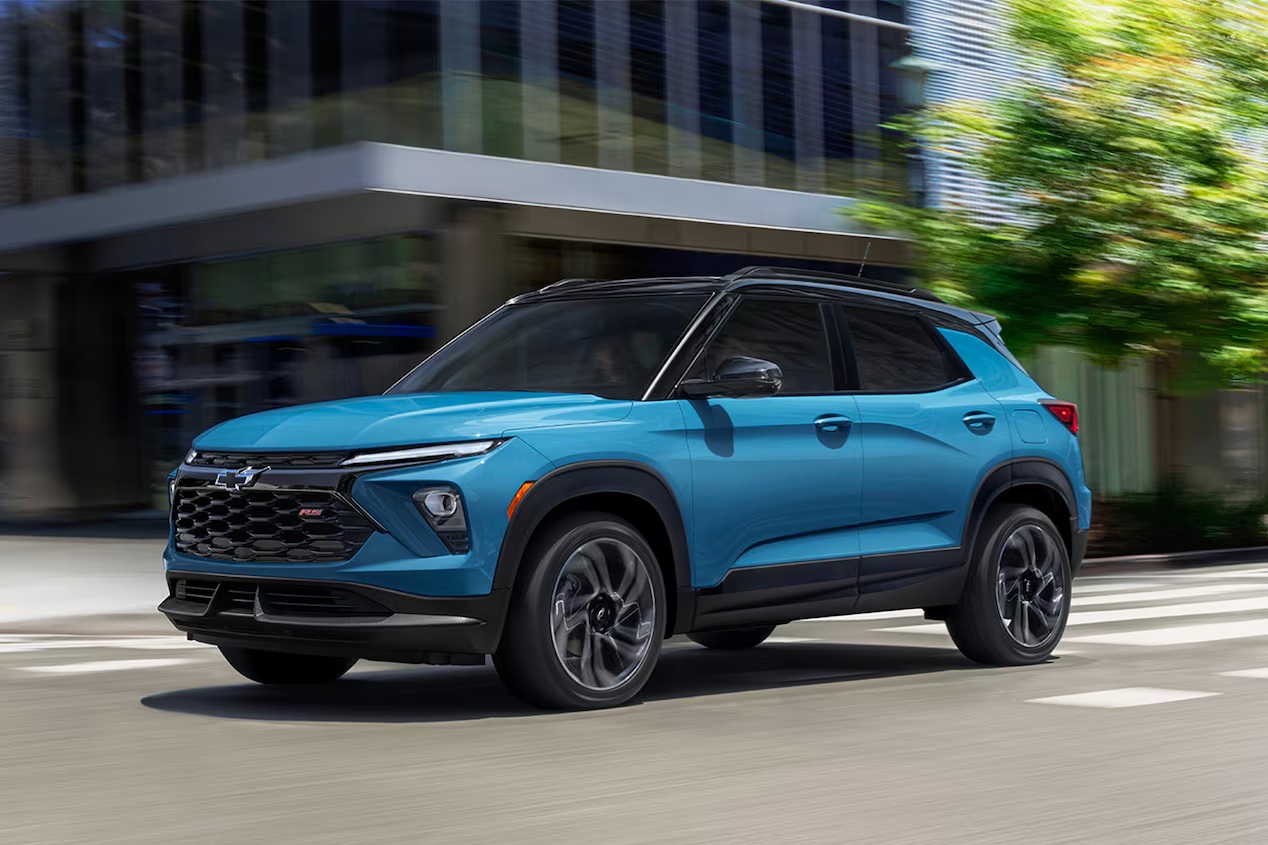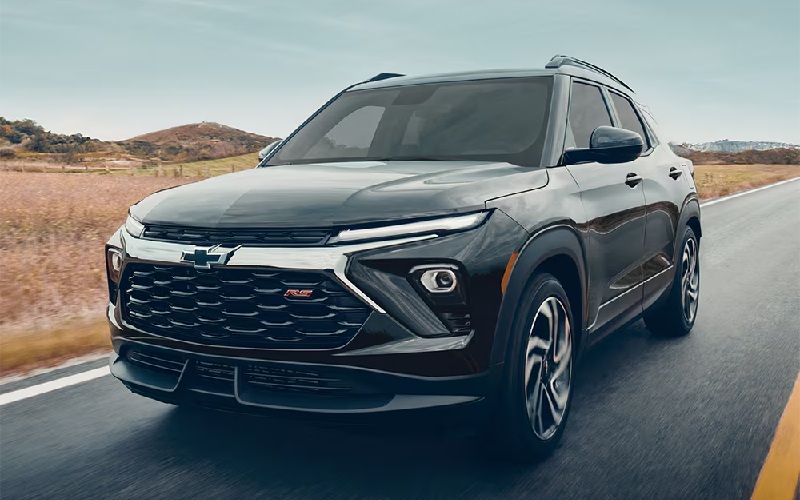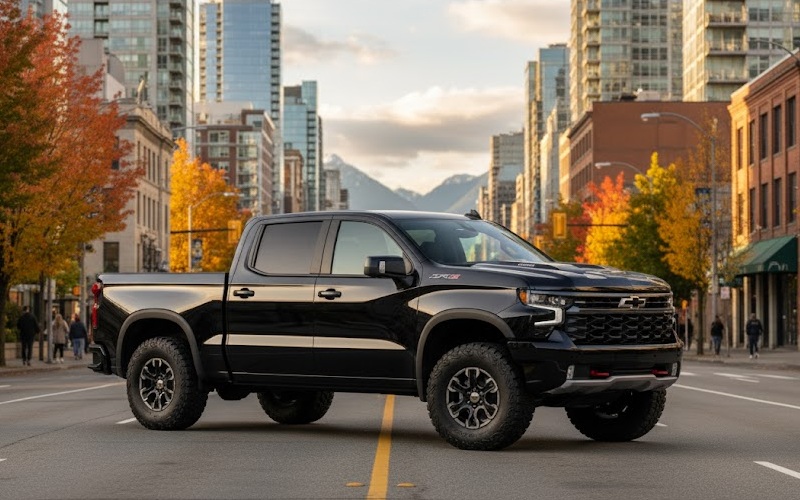137-HP vs. 155-HP Engine in the 2025 Chevy Trailblazer
The Chevrolet Trailblazer continues to offer buyers a choice between two turbocharged powertrains that deliver distinctly different driving experiences despite their similar displacements. With the 1.2L producing 102 kW (137 hp) and the 1.3L generating 115 kW (155 hp), the power gap between these two engines might seem modest on paper, but translates to meaningful […]
The Chevrolet Trailblazer continues to offer buyers a choice between two turbocharged powertrains that deliver distinctly different driving experiences despite their similar displacements. With the 1.2L producing 102 kW (137 hp) and the 1.3L generating 115 kW (155 hp), the power gap between these two engines might seem modest on paper, but translates to meaningful differences on the road.

Technical Specifications
1.2L Turbocharged Three-Cylinder
The base 1.2L turbocharged inline-three engine serves as the entry point to the Trailblazer lineup with:
- 102 kW (137 hp) at 5,000 rpm
- 220 Nm (162 lb-ft) of torque at 2,500 rpm
- Continuously Variable Transmission (CVT) only
- Front-wheel drive configuration only
- Direct injection fuel delivery
- Dual overhead camshafts (DOHC)
- Variable valve timing
1.3L Turbocharged Three-Cylinder
The upgraded 1.3L turbocharged inline-three engine offers:
- 115 kW (155 hp) at 5,600 rpm
- 236 Nm (174 lb-ft) of torque at 1,600 rpm
- 9-speed automatic transmission (AWD models)
- CVT transmission (FWD models)
- Available in both FWD and AWD configurations
- Direct injection fuel delivery
- Dual overhead camshafts (DOHC)
- Variable valve timing
While both engines share the same basic architecture as turbocharged three-cylinder units, the 13 kW (18 hp) power advantage of the 1.3L engine is complemented by a more significant 16 Nm (12 lb-ft) torque increase that arrives 900 rpm earlier in the rev range. This earlier torque peak substantially impacts the driving experience, providing more immediate response during everyday driving.
Performance Metrics
The performance gap between these engines becomes more apparent when examining acceleration figures and passing ability:
Acceleration
- 0-100 km/h (0-62 mph):
- 1.2L FWD: approximately 9.9 seconds
- 1.3L FWD: approximately 8.7 seconds
- 1.3L AWD: approximately 9.1 seconds
The 1.2-second difference between the base 1.2L and the FWD 1.3L models represents a noticeable improvement in responsiveness, particularly during urban driving scenarios like merging onto highways or navigating busy intersections. The AWD version’s slightly slower acceleration compared to its FWD counterpart reflects the additional weight of the all-wheel-drive system.
Passing Performance
- 80-120 km/h (50-75 mph) passing time:
- 1.2L FWD: approximately 7.2 seconds
- 1.3L FWD: approximately 6.3 seconds
- 1.3L AWD: approximately 6.5 seconds
These figures illustrate the 1.3L engine’s advantage during highway passing maneuvers, where the additional power and torque combine with the responsive 9-speed automatic transmission in AWD models to deliver greater confidence when overtaking.
Fuel Economy: Efficiency Comparison
Perhaps surprisingly, the more powerful 1.3L engine delivers better fuel economy than the base 1.2L in most configurations, highlighting the engineering refinements Chevrolet has made to the larger displacement engine:
Combined Fuel Consumption Ratings
- 1.2L FWD with CVT: approximately 7.6 L/100 km
- 1.3L FWD with CVT: approximately 7.1 L/100 km
- 1.3L AWD with 9-speed: approximately 7.8 L/100 km
Despite its power advantage, the 1.3L FWD configuration stands out as the efficiency champion, consuming approximately 0.5 L/100 km less than the base 1.2L. This counter-intuitive efficiency gain stems from several factors, including the larger engine’s ability to operate in a more efficient part of its power band during typical driving conditions and the more sophisticated engine management software.
The AWD version of the 1.3L engine naturally uses slightly more fuel due to the additional mechanical components and weight. Still, many drivers in regions with significant seasonal weather changes find this modest efficiency penalty worthwhile for the added capability.
Driving Experience: Beyond the Numbers
While performance figures and specifications provide valuable context, the subjective driving experience reveals more significant distinctions between these two powertrains:
1.2L Turbo Character
The base 1.2L engine delivers adequate performance for daily commuting with a character defined by:
- A more pronounced turbo lag before power delivery
- Greater need to plan ahead for passing maneuvers
- Engine noise that becomes more pronounced under acceleration
- Adequate but uninspiring highway cruising capability
- CVT transmission that prioritizes efficiency over engagement
1.3L Turbo Character
The 1.3L engine transforms the Trailblazer driving dynamics with:
- Noticeably more immediate throttle response
- A broader powerband that feels more flexible in varied driving conditions
- Reduced need to depress the accelerator for merging and passing fully
- More refined engine note, particularly at higher revs
- Superior highway cruising ability with greater reserve power
- 9-speed automatic in AWD models that provides more decisive gear selection
Perhaps most significantly, the 1.3L engine’s earlier torque peak (1,600 rpm vs. 2,500 rpm) translates to more accessible power during routine driving, where most drivers rarely exceed 3,500 rpm. This makes the 1.3L feel considerably more potent in real-world conditions than the raw horsepower figures might suggest.
Drivetrain Configurations and Transmission Pairings
The drivetrain options available with each engine significantly impact the overall driving experience:
1.2L Availability
- Front-wheel drive only
- Continuously Variable Transmission (CVT) only
- Standard on LS and LT trim levels
1.3L Availability
- Front-wheel drive with CVT
- All-wheel drive with 9-speed automatic
- Optional on LT, standard on ACTIV and RS trims
The 1.3L engine’s compatibility with the 9-speed automatic transmission in AWD configurations represents a substantial upgrade over the CVT. While modern CVTs have improved considerably, the 9-speed automatic provides more direct engagement and predictable acceleration characteristics that many drivers prefer, particularly when combined with the more powerful engine option.
The selectable drive modes (Normal, Snow, and Sport) also behave differently between the two engines, with the 1.3L engine’s additional power allowing for more pronounced differences between settings, particularly in Sport mode.
Trim-Specific Tuning Considerations
Each Trailblazer trim level features specific suspension tuning that complements the engine characteristics:
ACTIV with 1.3L Engine
The off-road oriented ACTIV trim, exclusively available with the 1.3L engine, features:
- Specially tuned dampers for enhanced off-pavement capability
- 17-inch all-terrain tires with a more aggressive tread pattern
- Sport terrain drive mode for unpaved surfaces
- 25 mm increased ground clearance over standard models
The 1.3L engine’s additional low-end torque proves particularly beneficial in this application, providing the necessary power for navigating loose surfaces and inclines without requiring excessive throttle input that might compromise traction.
RS with 1.3L Engine
The sportier RS trim, also exclusively paired with the 1.3L engine, includes:
- Firmer suspension tuning for more responsive handling
- Quicker steering ratio
- Sport mode calibration that enhances throttle response
- Transmission programming that holds gears longer in spirited driving
In this sport-oriented configuration, the 1.3L engine’s higher power output complements the more athletic chassis setup, creating a more cohesive performance-focused driving experience.
Real-World Performance Scenarios
To better illustrate the practical differences between these engines, consider how they perform in common driving scenarios:
Urban Commuting
In stop-and-go traffic, the 1.3L engine’s earlier torque peak provides more effortless acceleration from traffic lights without needing to rev the engine aggressively. This creates a more relaxed driving experience with less need to depress the accelerator for routine acceleration fully.
Highway Cruising
Both engines offer sufficient power for highway speeds, but the 1.3L provides significantly more confidence for passing maneuvers and hill climbing without requiring dramatic downshifts or high engine speeds. The 1.3L AWD configuration with the 9-speed automatic feels particularly composed at highway speeds with more immediate response when additional power is requested.
Challenging Conditions
In adverse weather or on unpaved roads, the 1.3L AWD configuration delivers a substantial advantage. The combination of the more powerful engine, all-wheel drive capability, and the responsive 9-speed transmission allows for more controlled application of power, enhancing overall capability and driver confidence.
Cargo and Passenger Loading
When the Trailblazer is full with passengers and cargo, the performance gap between these engines becomes even more pronounced. The 1.2L engine feels noticeably burdened by additional weight, while the 1.3L maintains more of its responsiveness and efficiency when carrying heavier loads.
Making the Right Choice: Which Engine Suits Your Needs?
While the 1.3L engine offers clear performance advantages, the right choice depends on individual driving requirements and priorities:
The 1.2L Engine Makes Sense For:
- Primarily urban and suburban driving with limited highway needs
- Drivers prioritizing initial acquisition cost over performance
- Situations where all-wheel drive capability isn’t necessary
- Drivers who place greater emphasis on simplicity than performance
- Regions with flat terrain and mild weather conditions
The 1.3L Engine Is Better Suited For:
- Drivers who regularly travel on highways or in hilly terrain
- Those seeking the option of all-wheel drive capability
- Anyone who regularly carries multiple passengers or cargo
- Drivers preferring the more traditional feel of the 9-speed automatic
- Buyers interested in the ACTIV or RS trim levels
- Those seeking the most efficient FWD configuration
2025 Chevy Trailblazer: A Meaningful Choice
The 13 kW (18 hp) difference between the two Trailblazer engine options represents more than just a minor power bump—it fundamentally changes the vehicle’s character, capabilities, and configurations available to buyers. While the 1.2L provides adequate performance for basic transportation needs, the 1.3L transforms the Trailblazer into a more confident, capable, and in many cases, more efficient vehicle.
The 1.3L engine’s broader availability across trim levels, compatibility with all-wheel drive and the 9-speed automatic transmission, and its superior torque profile make it the more versatile option that better showcases the full potential of the Chevy Trailblazer. For most buyers, the performance, efficiency, and expanded capability of the 1.3L engine will more than justify its position as the premium powertrain option in the Trailblazer lineup.
Rather than viewing these engines as minor variations on the same theme, prospective buyers should consider them distinct powertrains that create noticeably different driving experiences, despite their similar displacement and configuration. This understanding transforms what might initially seem like a modest power gap into a meaningful choice that significantly impacts the ownership experience.


